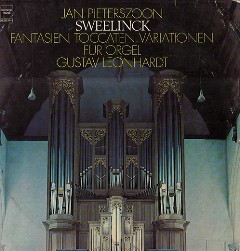Jan Pieterszoon Sweelinck - Organ Works (1998)
Jan Pieterszoon Sweelinck - Organ Works (1998)

1. Echo Fantasia in A minor 4:20 play 2. Da pacem, Domine, in diebus nostris 8:44 3. Hexachord Fantasia No. 5 9:53 4. Fantasia No. 4 in D minor 13:41 5. Puer nobis nascitur - Ons is gheboren 3:33 6. Toccata No. 17 in A minor 5:25 Gustav Leonhardt – organ St.Jakobskerk, Den Haag
Jan Pieterszoon Sweelinck (Deventer, April or May, 1562 – Amsterdam, 16 October 1621) was a Dutch composer, organist, and pedagogue whose work straddled the end of the Renaissance and beginning of the Baroque eras. He was among the first major keyboard composers of Europe, and his work as a teacher helped establish the north German organ tradition.
Sweelinck represents the highest development of the Dutch keyboard school, and indeed represented a pinnacle in keyboard contrapuntal complexity and refinement before J.S. Bach. However, he was a skilled composer for voices as well, and composed more than 250 works for voice (chansons, madrigals, motets and Psalms). Some of Sweelinck's innovations were of profound musical importance, including the fugue—he was the first to write an organ fugue which began simply, with one subject, successively adding texture and complexity until a final climax and resolution, an idea which was perfected at the end of the Baroque era by Bach. It is also generally thought that many of Sweelinck's keyboard works were intended as studies for his pupils. He was also the first to use the pedal as a real fugal part. Stylistically Sweelinck's music also brings together the richness, complexity and spatial sense of Andrea and Giovanni Gabrieli, with whom he was familiar from his time in Venice, and the ornamentation and intimate forms of the English keyboard composers. In some of his works Sweelinck appears as a composer of the baroque style, with the exception of his chansons which mostly resemble the French Renaissance tradition. In formal development, especially in the use of countersubject, stretto, and organ point (pedal point), his music looks ahead to Bach (who was quite possibly familiar with Sweelinck’s music).
Sweelinck was a master improviser, and acquired the informal title of the "Orpheus of Amsterdam". More than 70 of his keyboard works have survived, and many of them may be similar to the improvisations that residents of Amsterdam around 1600 were likely to have heard. In the course of his life, Sweelinck was involved with the musical liturgies of three distinctly different church types: the Roman Catholic, the Calvinist, and the Lutheran—all of which are reflected in his work. Even his vocal music, which is more conservative than his keyboard writing, shows a striking rhythmic complexity and an unusual richness of contrapuntal devices.
Jan Pieterszoon Sweelinck (ur. w kwietniu 1562 w Deventer, zm. 16 października 1621 w Amsterdamie) - holenderski organista, kompozytor i pedagog. Skomponował liczne wariacje, toccaty, fantazje oraz madrygały, psalmy, motety. Był ostatnim wielkim mistrzem franko-flamandzkiej szkoły polifonii wokalnej, a zarazem twórcą przełomu renesansu i baroku.
download: uploaded yandex 4shared mediafire solidfiles mega zalivalka filecloudio anonfiles oboom
Last Updated (Wednesday, 21 May 2014 14:58)








